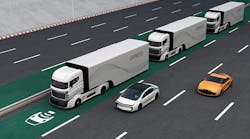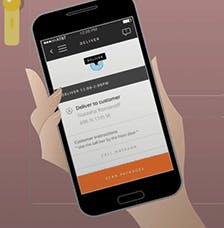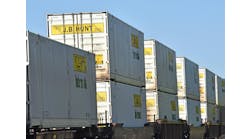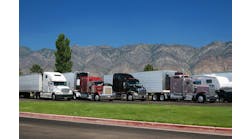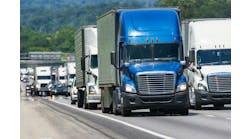Global consulting firm KPMG anticipates that as early as 2030, a new mobility services segment will emerge worth well over $1 trillion dollars for products and services related to autonomy, mobility and connectivity. According to KPMG's 2017 Global Automotive Executive Study, which polled nearly 1,000 executives with the world's leading automotive companies, 76% say just one connected vehicle generates more revenue streams than 10 conventional vehicles.
At the center of this revolution are emerging deep learning and artificial intelligence (AI) tools; sensor technologies that let trucks, vans or material handling equipment "see"; on-board supercomputers that allow them to become autonomous; near-ubiquitous over-the-air connectivity; and a set of new business models that unlock value from all of that technology.
Even in advance of autonomous vehicles we are beginning to see the early impacts of these technologies in the e-commerce and delivery sectors. Following the success of Uber (which today can get a car to 67% of the U.S. population within 10 minutes), Amazon launched its Amazon Flex application, which opens up last-mile parcel delivery to everyday vehicle owners as a similar transportation service on-demand. In conjunction with an expanding footprint of regional distribution centers and a growing fleet of Prime Air freighters, Amazon promises to change the game in parcel delivery—lowering delivery costs while simultaneously enabling same-day delivery in major metro markets. Already, Amazon-owned assets selectively service up to 44% of the U.S. population.
Moreover, with the growing sophistication of e-commerce data collection capabilities and advances in deep learning and AI, large online retailers like Amazon and Walmart.com will likely be able to understand customer order patterns and predict demand far better than ever before, enabling them to invest even more in forward-deployed, local inventory. This could put even more pressure on the parcel delivery players. As online retailers are able to fulfill more customer demand cheaply and quickly from local warehouses, they could need much less of one of the most profitable services of the major parcel delivery firms: overnight shipping. Ironically, while Amazon's investment in Prime Air acknowledges the criticality of overnight delivery today, Amazon's investments in understanding customer behavior might serve to undermine that criticality tomorrow.
Deployed together, these emerging technologies offer potentially powerful alternatives to the integrated parcel delivery business models that today predominate. It is not just USPS, FedEx and UPS that need to beware, however—"same-day delivery" is a game-changer for retail. With more products able to be reliably ordered for delivery "this afternoon," brick-and-mortar retail traffic and volumes will suffer. As "same-day assortment" and selection improves, those e-retailers without the scale and volumes to deeply understand customer demand and forward deploy local inventories into major metro markets will be at a disadvantage in product categories and customer segments where immediacy of fulfillment dominates product feature or assortment.
In long-haul trucking the potential may be as profound. Early pilots by Daimler, Otto (Uber) and others have demonstrated the feasibility of fully autonomous on-highway operation and offer the potential to safely open up four to six productive, on-road travel hours a day during which today's two-driver rigs are parked for crew rest—often while idling and burning fuel to maintain cabin AC or heat. Platooning experiments by others such as Peloton are reporting on-highway fuel savings of 7-14% with vehicle-to-vehicle communications systems that allow multi-truck convoys to safely draft off of one another, slaving one or more rigs to the control of a lead truck. These are giant levers of profitability, with driver wages and fuel cost currently accounting for approximately 65% of operating cost per mile.
The economic and societal potential is fantastic and will likely reshape the trucking and logistics industries. Higher rig utilizations and reduced on-highway fuel consumption will erode some of today's rail and intermodal cost advantages and in so doing open up more time-critical loads to the trucking industry. New, lower-cost last-mile options will open additional home and small-office delivery markets. More local, targeted deployment of inventory will reduce the need for overnight air shipping, simultaneously lowering the cost and increasing the speed of delivery. Already in some global markets, we're seeing reduced personal vehicle transit for shopping missions in favor of home delivery.
It's not just the technology that is changing. Consumers are increasingly responding to these new models. In fact, the rapid development and adoption of these technologies fuels and is fueled in part by the similarly rapid evolution of customer purchasing behaviors, including the demand for ever-faster fulfillment, the increasing expectation of free or very-low-cost delivery, the willingness—even eagerness—to purchase online (including once "off-limits" items like fresh fruits and vegetables), and the acceptance of novel delivery mechanisms. Consider, for example, some of the manifestations of the "sharing economy," in which consumers sleep in strangers' homes (e.g., AirBNB), get into strangers' cars (Uber, Lyft), and routinely allow strangers without uniforms (e.g., Uber Rush) to deliver packages to and in some cases into their homes.
Industry-shaping change is coming to retailing, consumer products, logistics and trucking as a start.
First-movers are likely to be able to apply cost and speed advantages to grow share from late adopters. Success (or even survival) requires a clear view of where the market is likely to evolve to, thoughtfulness around changes to your go-to-market and organizational structures, a broad understanding of technology options, active engagement with potential new partners or acquisition candidates, and a focus on applying new technologies or business models to create an engine for sustained growth.
Tom Mayor is the national strategy leader for KPMG's Industrial Manufacturing practice. He holds an MBA from Dartmouth College's Tuck School of Business and focuses on supply and manufacturing strategy, operations turnaround, purchasing and supply base management, with a focus on automotive, aerospace and industrial clients.
Talley Lambert leads the Operations group in KMPG's Strategy Practice. He focuses on growth and operations strategy and has experience helping clients deal with disruptive change. He works mostly with industrial and automotive clients. He holds an MBA from Harvard Business School.
